#embolotherium
Explore tagged Tumblr posts
Text
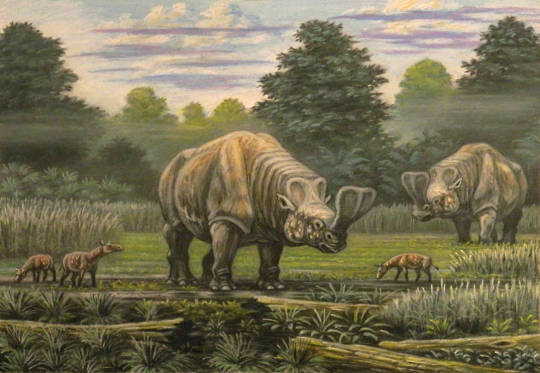


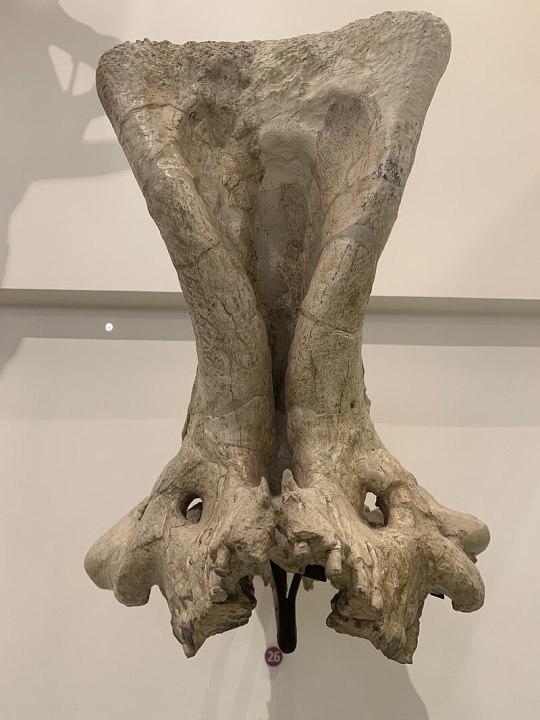


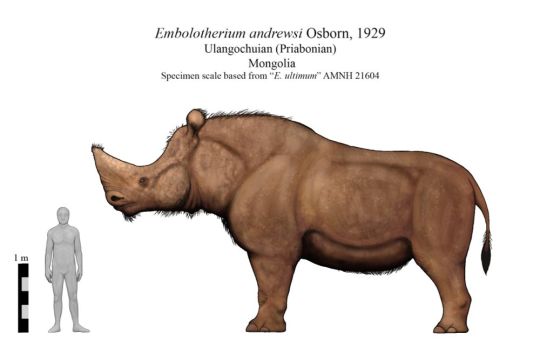
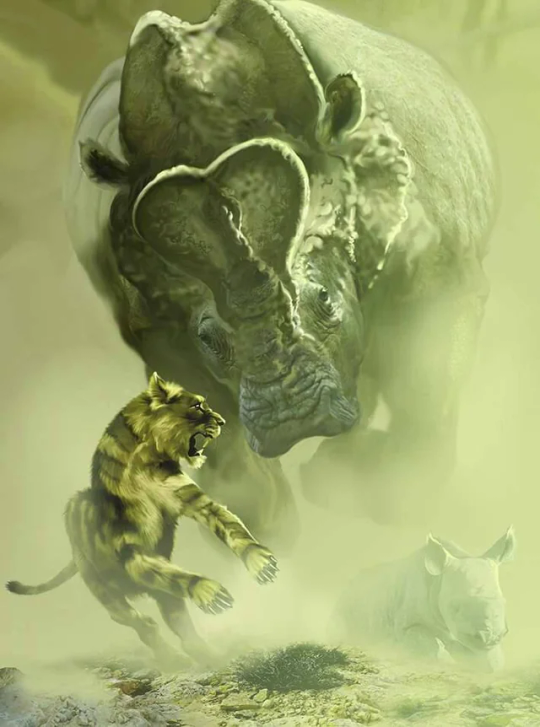




Embolotherium is an extinct genus of brontothere that lived throughout what is now Asia during the late Eocene epoch some 41 to 34 million years ago. The first remains known of embolotherium consisted of several partial skulls recovered from the Ulan Gochu formation of Inner Mongolia, which were described by Henry Fairfield Osborn in 1929. With the name Embolotherium coming from the greek emboli meaning wedge and therion meaning beast, translating fully to either wedge beast or battering ram beast. Since then several additional skulls, jaws, and a variety of other skeletal elements have been recovered from both the Ulan Gochu formation as well as the Ergilin Dzo Formation of Outer Mongolia. With there being two species recognized today: Embolotherium andrewsi and Embolotherium granger. Additionally another genus of brontothere, Titanodectes, which was named for several lower jaws found in the same sedimentary deposits as Embolotherium, probably represents the same animal. Though a complete skeleton of embolotherium has yet to be recovered, it is estimated that this beast would have reached around 8.2ft (2.5m) tall at the shoulder, 15.2ft (4.6m) in length, and 7,200 to 8,400lbs (3265 to 3810kgs) in weight. Unlike many of the other Late Eocene brontotheres, there is no clear evidence that Embolotherium was sexually dimorphic. All known specimens have large rams. Therefore, coupled with the fact that the rams were hollow and fragile in comparison to the solid and sturdy horns of the North American brontotheres, such as Megacerops, it does not seem likely that the ram served as a weapon for contests between males. Rather, it might have had a non-sexual function, such as signaling to each other. The ram may have served as a specialized resonator for sound production. This hypothesis is suggested by the fact that the bony nasal cavity extends to the peak of the ram, thus implying that the nasal chamber was greatly elevated, possibly creating a resonating chamber.
Art used can be found at the following links
https://nixillustration.com/tag/embolotherium/
#pleistocene pride#pliestocene pride#eocene#cenozoic#paleontology#prehistoric#prehistoric animal#animal facts#fossil#naturalhistory#embolotherium#extinct animals
1 note
·
View note
Text




Results from the #paleostream!
A spec evo wish by Bear Rangell, Embolotherium (another wish), Saadanius (newest #MonkeyCruise) and Protuberum.
424 notes
·
View notes
Text

Embolotherium. gouache on paper
80 notes
·
View notes
Text
Brontothere
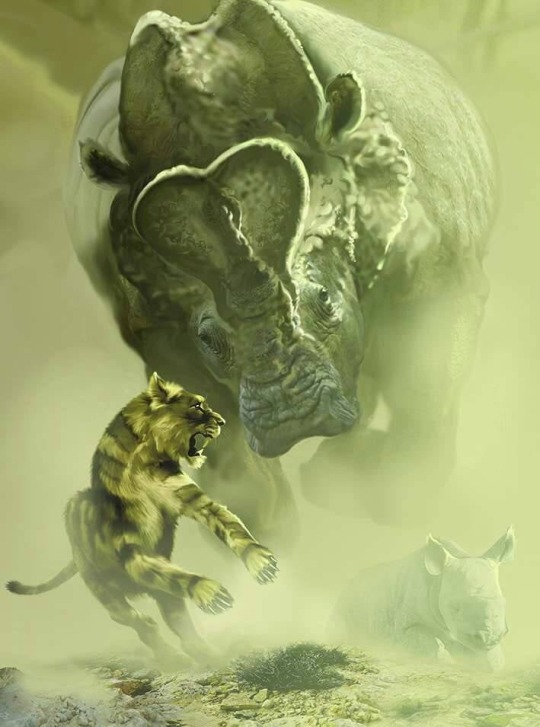
Megacerops protects cubs (Jan Sovak)
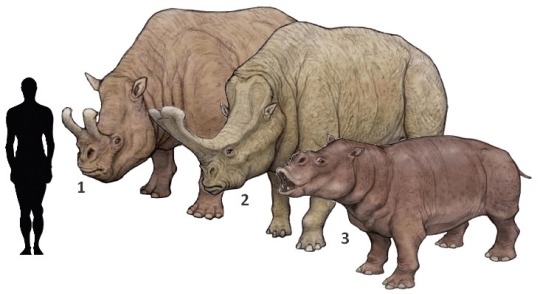
1. Megacerops coloradensis
2.Embolotherium grangeri
3.Metamynodon planifrons (Metamynodon is actually an amynodont)
brontotheres, with uintatheres, being the best small brained herbivores
Grigorosuchus Hunting a Gondwanian Multiungulate
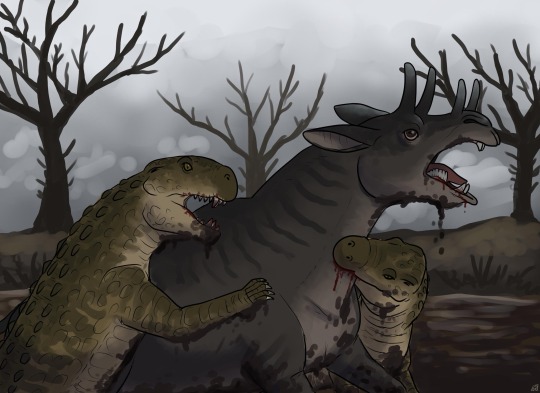
0 notes
Text
Wtf happened to Embolotherium’s face
Got a humongous snuffleupagous


PALEOGENE animals chart
these are some of the many animals featured in my new video dedicated to the Paleogene Period
__ it's not also available at Redbubble for prints and more here ________
Instagram
Youtube channel
Prints and more merch
165 notes
·
View notes
Photo

patience
522 notes
·
View notes
Photo

She can’t let go.
Embolotherium mother and calf
Patreon • Ko-fi • Facebook • Twitter • Prints & Merch
716 notes
·
View notes
Photo

Weird Heads Month #16: Big Honking Snoots
The dinoceratans featured here a few days ago were some of the first large mammalian herbivores to evolve in the Cenozoic, but during the Eocene they were joined by another group: the even bigger brontotheres.
Part of the odd-toed ungulate lineage, brontotheres convergently resembled rhinos but were actually much more closely related to horses. And much like the dinoceratans they also had some unusual heads, with some species evolving concave foreheads and sexually dimorphic ossicone-like pairs of blunt horns on their noses.
But others went really weird.
Embolotherium andrewsi lived in Mongolia during the late Eocene, around 37-34 million years ago. Standing around 2.5m tall at the shoulder (8'2"), it was one of the largest brontotheres and also one of the oddest-looking.
It had a large bony "battering ram" at the front of its snout, formed from modified nasal bones – and while some reconstructions tend to shrinkwrap this structure as a horn, the fact that the nasal cavity appears to have extended all the way to its tip suggests that it was actually supporting a huge bulbous nose.
Since Embolotherium also doesn't seem to have been sexually dimorphic like other brontotheres, its enormous ridiculous-looking snoot may instead have been a resonating chamber used for sound production and communication.

———
Nix Illustration | Tumblr | Pillowfort | Twitter | Patreon
#weird heads 2020#science illustration#paleontology#paleoart#palaeoblr#embolotherium#brontothere#hippomorpha#perissodactyla#ungulate#mammal#art#that is an excellent snoot#big honkin' snoots
265 notes
·
View notes
Photo
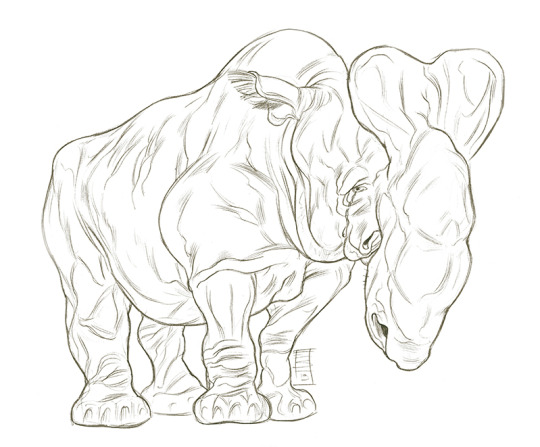
Sketch_Embarassed Embolotherium.
Pencils, 2019.
32 notes
·
View notes
Note
Where were Embolotheriums nostrils (likely) at? I've seen reconstructions with the nostrils on the side of the face where a rhinoceros' nostrils are but I've also seen the nostrils placed at the top of their horn/ram things
5 notes
·
View notes
Text

“In the course of twenty million years, mammals got more and more successful until they were the biggest, fiercest, and most spectacular animals on the planet. Whatever the climate, whatever the habitat, mammals made it their own. Their great strength was their ability to adapt. They grew to gigantic sizes, they evolved into powerful killers like the famous sabre-tooth cats, and they even laid claim to the oceans.”
- Kenneth Branagh, prologue to “Walking with Beasts”
Sketches of some of the incredible wildlife of the Cenozoic Era. None of the animals are exactly shown to scale. From left to right, bottom to top:
Arctocyon, Barylambda, Coryphodon, Titanoboa
Uintatherium, Notharctus, Mesonyx, Eobasileus
Leptictidium, Gastornis, Propaleotherium, Titanomyra, Godinotia, Pakicetus, Ambulocetus
Apidium, Arsinotitherium, Andrewsarchus, Embolotherium, Moeritherium, Dorudon, Basilosaurus, Perucetus
Megacerops, Cainotherium, Merycoidodon
Cynodictis, Paraceratherium, Hyaenodon gigas, Chalicotherium, Paraentelodon
Gentilicamelus, Amphicyon, Daeodon, Moropus, Dinocrocuta, Platybelodon, Gomphotherium, Pelagornis, Purussasaurus, Odobenoceratops, Otodus megalodon
Phoruschracos, Astrapotherium, Teleoceras, Synthetoceras, Samotherium, Livyatan
Australopithecus afarensis, Deinotherium, Ancylotherium, Dinofelis
Mammuthus columbi, Smilodon fatalis, Bison latifrons, Aenocyon dirus, Arctodus simus, Panthera atrox, Titanotylopus, Equus hersternus, Sivatherium, Gigantopithecus, Paleoloxodon
Smilodon populator, Macrauchenia, Doedicurus, Megatherium, Glyptodon, Toxodon
Mammuthus primigenius, Megaloceros giganteus, Coelodonta antiquitatis, Bos primigenius, Homo neanderthalensis, Elasmotherium, Bison bonasus
#paleoart#paleontology#cenozoic mammal#cenozoic animals#cenozoic mammals#cenozoic era#cenozoology#cenozoic#palaeontology#paleoartist#artists on tumblr#paleoartists on tumblr#paleoblr#paleogene#neogene#quaternary#paleocene#eocene#oligocene#miocene#pliocene#pleistocene#palaeoart#paleo#palaeoblr#paleoillustration
61 notes
·
View notes
Photo
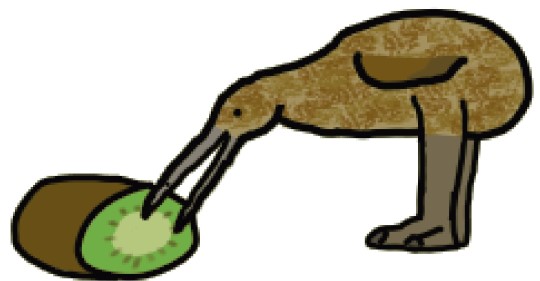
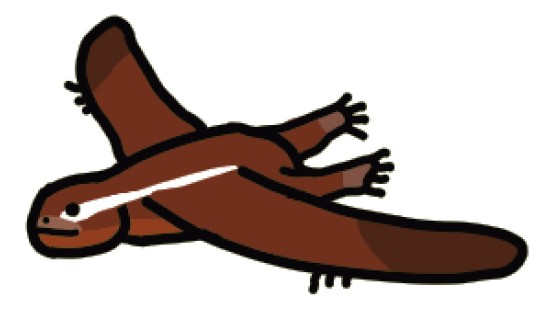

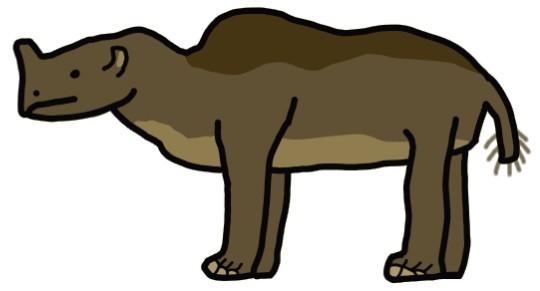
Flocking Together
Proapteryx
Jeholopterus
Styxosaurus
Embolotherium
1 note
·
View note
Note
For the late birthday of the late Marin Mizuta, Akira gets his room absolutely thrashed by an Embolotherium.

Oh come on...I didn't even kill that one!
2 notes
·
View notes
Note
HEHEHE HIII, what are YOUR favourite dinosaurs/prehistoric species!!
OOOOOOOHHH BAPY ITS TIME. Thanks for asking!!!! I could literally talk about dinosaurs and palaeontology for days without stopping if you’d let me. You have opened Pandora’s box and it ain’t shutting.
Sosososo I’ve always been a fan of the sauropods, and Brachiosaurus was my first favourite dinosaur, but it was pretty quickly overtaken by Sauroposeidon!! This behemoth from middle Cretaceous USA has often been restored as a pumped-up Brachiosaurus due to its incomplete nature, leading to height estimates of up to 18m tall!!!! MAKING IT THE TALLEST ANIMAL TO EVER EXIST!!!!!! That’s pretty sick in my opinion, though more recent estimates have shaved it down to a still impressive 15m after considering its place on the sauropod evolutionary tree, closer to the titanosaurs than Brachiosaurus is. Sorry I couldn’t help but say my piece about Sauroposeidon while I had the opportunity. It’s still my favourite dinosaur, though the mysterious Bruhathkayosaurus did hold the title for a little while when I was like 8? 9? And I sometimes consider Dreadnoughtus to be joint favourite thanks to a combination of Prehistoric Planet and some talks that I listened to by its discoverer, Kenneth Lacovara.
OTHER FAVOURITE (non avilaean) DINOSAURS INCLUDE, in no particular order:
SAUROPODOMORPHS
Dreadnoughtus, as I mentioned
Unaysaurus
Argentinosaurus
Apatosaurus, PALAEOACCURATE ONLY
Mamenchisaurus
Liaoningtitan
Brachiosaurus
Dzharatitanis
THEROPODS
Dakotaraptor, thanks to Saurian
Latenivenatrix
Zhenyuanlong, thanks to Steve Brusatte
Therizinosaurus
Anzu, again, Saurian
Khaan
Yutyrannus, particularly when restored with the headcrest
Juratyrant
Gorgosaurus
Metriacanthosaurus
Saurophaganax, mainly because it has a kickass name
Carcharodontosaurus
Neovenator, obviously
Eustreptospondylus
Baryonyx
Oxalaia, which is really fun to say
Masiakasaurus
Dracovenator, like Dilophosaurus but more obscure. And from South Africa.
Coelophysis
ORNITHISCHIANS
Triceratops
Turanoceratops
Protoceratops, thanks to Dinosaur Planet
Stegoceras
Aralosaurus
Edmontosaurus, particularly E.annetens
Saurolophus
Charonosaurus, like Parasaurolophus but more obscure. And from China.
Maiasaura, because in BestInSlot hated it in Jurassic World Evolution so it reflexively became one of my favourites out of spite/pity. It’s also cool in its own right don’t get me wrong.
Orodromeus. Hee hee. She dig
Lurdusaurus. I actually think it was Beasts of Bermuda that sold me on this one
Altirhinus. The schnoz on this man
Iguanodon
Rhabdodon
Dryosaurus
Heterodontosaurus
Scelidosaurus, particularly after seeing Prehistoric Kingdom’s rendering of it
Jakapil, newly discovered and straight on the list babey
Stegosaurus
Tuojiangosaurus. Spikey
Sauropelta
Borealopelta. WE KNOW WHAT COLOUR IT WAS!!!!
Ankylosaurus
Saiachania. Yes it is because of Dinosaur King.
Crichtonsaurus
Ok I lied there was an order. I sorted them by taxonomic Order. Also sorry there was so many I kept thinking of more. That was 52 I total??? 53 if you include Sauroposeidon. I just couldn’t decide.
BUT WAIT THERE’S MORE!!!!!
Particularly as of recent, I’ve become really interested in non-dinosaurs, particularly the megafauna of Cenozoic South America. Though I do have a side blog dedicated to lomg whale Basilosaurus, it’s tying with the terror bird Devincenzia for the top spot I think.
OTHER FAVOURITES INCLUDE:
BIRDS
Kelenken, another terror bird
Gastornis, thought to be terror bird-esque up until recently when it was revealed to be a fruit eater
Dinornis, the Moa
Hieriaaetus, Haast’s Eagle
Confusciousornis
Anchiornis, if you consider it a bird
Vegavis
MAMMALS
Megatherium, the largest of the giant ground sloths
Doedicurus
Panochtus
Macrauchenia
Toxodon, which probably lived like a hippo
Thylacosmilus
Hyaenodon, in all its many species
Enteldon, my favourite of the Entelodonts
Embolotherium, the best looking brontothere imo
Chalicotherium
Ancylotherium. I would say thanks to walking with beasts but I think that applies to too many animals here.
Deinotherium
Platybelodon, which I stumbled across in an old encyclopaedia with a friend and had a good laugh at
Coelodonta
Paraceratherium
Leptictidium. The schnoz on this man.
NON-DINOSAURIAN ARCHOSAURS
Hatzegopteryx. WHADDA GAL AMIRITE?
Barbaridactus, thanks to Prehistoric Planet
Tupandactylus
Tropeognathus, thanks to Walking With Dinosaurs, even if they do call it Ornithocheirus.
Thalassodromeus
Istiodactylus
Germanodactylus
Archosaurus. The schnoz on this man
Silesaurus, which is NOT a dinosaur
Desmatosuchus
Saurosuchus, a big land croc
Redondasaurus, one of the largest Phytosaura
Erythrosuchus, with its huge stupid head
Areripesuchus
Dakosaurus, a sea croc
Plesiosuchus, one of the largest sea crocs
Purussaurus
Barinasuchus
Quinkana, the last of the land crocs
NON-ARCHOSAURIAN SAUROPSIDS
Varanus priscus, aka Megalania
Mosasaurus
Tylosaurus
Thalassotitan, also because it has a kickass name
Platecarpus
Pliosaurus, particularly P. rossicus
Kimmerosaurus
Rhomaleosaurus
Tuarangisaurus
Nothosaurus
Temnodontosaurus
Opthalmosaurus
Tanystropheus. NECK
Longisquama
Coelurosauravus. It’s a liddle flying lizard!
Scutosaurus. Chonky dude
NON-MAMMALIAN SYNAPSIDS
Inostrancevia, thanks to Primeval
Lycaenops
Diictodon
Placerias
Lystrosaurus, the survivor
Estemmenosuchus
Tapinocephalus, a barrel of a beast
Edaphosaurus
Dimetrodon
Ophiacodon
NON-AMNIOTE CHORDATES
Koolasuchus, the last of the giant amphibians
Metoposaurus
Prionosuchus
Anthracosaurus
Hynerpeton, thanks to Walking With Monsters
Macnamaraspis
Xiphactinus
Thrissops
Cladoselache, a shark relative
OTHER
Arthropleura
Pulmonoscorpius
Pterygotus
Lyrarapax
Opabinia. IT HAS 5 EYES!!!!
Perisphinctes, a Jurassic ammonite
Belemnotheutis, a Jurassic belemnite
Paradoxoides, a Cambrian trilobite
Ok that’s finally everything. APART FROM THE PLANTS no I’m joking. You see what I said about days? Yeah.
Thank you again for the ask! I hope this wasn’t to much :3
9 notes
·
View notes
Text
Dinosaur Representation in Film
Just on a lark, I decided to go over as many dinosaur films (features, as well as theatrical shorts) and see just how often things were represented. Here are a few things I learned.
Tyrannosaurus rex is by far the most popular dinosaur, with 72 showings that I was able to track down.
The top 10 Dinosaurs overall were:
Tyrannosaurus
Brontosaurus/Apatosaurus
Triceratops
Stegosaurus
Parasaurolophus/Charonosaurus
“Velociraptor”/Dakotaraptor
Brachiosaurus
Allosaurus
Ankylosaurus
Saurolophus
Top 10 Theraopds:
Tyrannosaurus
Velociraptor/Dakotaraptor
Allosaurus
Ornithomimis/Struthiomimus
Ceratosaurus
Deinonychus
Carnotaurus
Compsognathus
Gallimimus
Troodon
Top 5 Sauropods
Brontosaurus/Apatosaurus
Brachiosaurus
Diplodocus
Supersaurus/Ultrasauros
Alamosaurus
Top 5 Ornithopods:
Parasaurolophus/Charonosaurus
Saurolophus
Edmontosaurus/Trachodon/Anatosaurus/Anatotitan
Iguanodon
Hypsolophodon
Top 4 Thyrophora
Stegosaurus
Ankylosaurus
Kentrosaurus
Polacanthus
Top 5 Marginocephalia
Triceratops
Styracosaurus
Pachycephalosaurus
Centrosaurus/Monoclonius
Chasmosaurus
There are 14 The Land Before Time films. This skews some numbering a little (Saurolophus wouldn’t be so high without it, and its absence would put Ceratosaurus tied with Ornithomimus/Struthiomimus would in the top 10 dinosaurs, and ).
There are movies that show off amazing things like Therizinosaurs, Microcaptor, and Oviraptorids, but most of them are from Asia (India, Korea, and Japan).
Prehistoric Mammal diversity is pretty weird in film.
“Gigantopithicus”
Megalonyx/Ground Sloth
Wooly Mammoth
Cronopio (”Saber-Toothed Squirrel”)
Ape-Man/Neanderthal
Smilodon
Glyptodon
Paleotherium
Embolotherium
Megacerops
As with The Land Before Time, Ice Age and its related films skews the mammal ones, but does add some fun things to the list.
It does force out Uintatherium and Eohippus.
Among pterosaurs, Ptreranodon dominates worse than even T. rex. And that’s not taking into account Geosternbergia.
Similarly, Elasmosaurus dominates sea-going reptiles, but not AS much. Mosasaurus is a close second.
Archaeopteryx and a Phoruschacoid dominate bird appearances.
Among arthropods, giant prehistoric scorpions actually outnumber giant, prehistoric spiders.
I ended up classifying some animals as Ludodactylus, Erythrosuchus, and Shringasaurus. And I feel I shouldn’t have to explain why.
Dimetrodon was the most commonly shown Permian animal, but I was surprised to find both Edaphosaurus and Scutusaurus in proper movies!
50 notes
·
View notes
Text
@downwithwritersblock
Guess I should probably link back to the prompts I’ve been using, huh? Anyway this one had me stumped, because everything I wanted to write for it was way way too spoilery, and I wanted to keep sharing these. So I didn’t even know what I was going to do for this one until yesterday.
-
Guide
-
Connor Temple’s Unofficial Guide to Surviving an Incursion
Don't panic. If you start panicking, you’re going to make a stupid choice that could get you killed. So just... don’t.
But I mean, it’s understandable if you do. I panic on a routine basis. Which actually probably accounts for the inordinate amount of near death experiences.
If you do panic, hide. That’s the only safe thing to do if you panic. Running might get you killed. Trying to confront the creature or get it back to the anomaly without a team or a plan could get you killed. Live to fight another day.
What was number three?
Oh, right. If anybody is with you, stay close. Creatures tend to act like the antagonist in a horror film, they’ll pick you off one by one. There’s safety in numbers.
Unless you’re facing a herd of Embolotherium. Then it’s actually numbers that will get you killed. In that case, there’s not really anything to do except to stay out of their way. Which is actually a lot harder than it sounds.
Oh, right, and keep quiet. Most creatures have far better hearing than us humans. You may not be able to hear them, but they can probably hear you. Especially the Future Predator. Actually, if you come face to face with a Future Predator, make a lot of noise. They have extra sensitive hearing, and loud noises will disorient them. Then run. Fast.
One last thing. Stay away from the anomalies. If you can manage to get whatever creature back through where it belongs, great. But seriously, stay out of the anomalies. Or you might just find yourself as the only person on the planet.
---------------------------------------------
I might write more to go with this later. It was fun.
#creative writing challenge#connor temple#primeval#Connor Temple’s Unofficial Guide to Surviving an Incursion#I write#I speak
8 notes
·
View notes